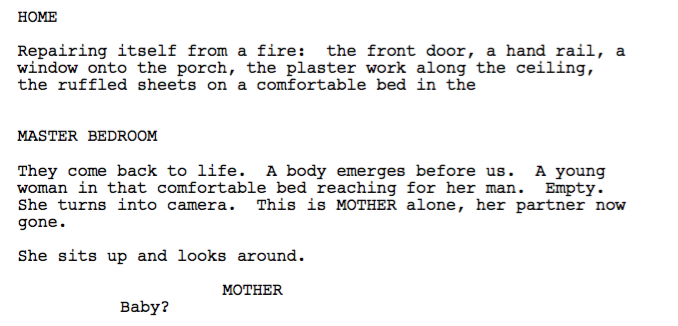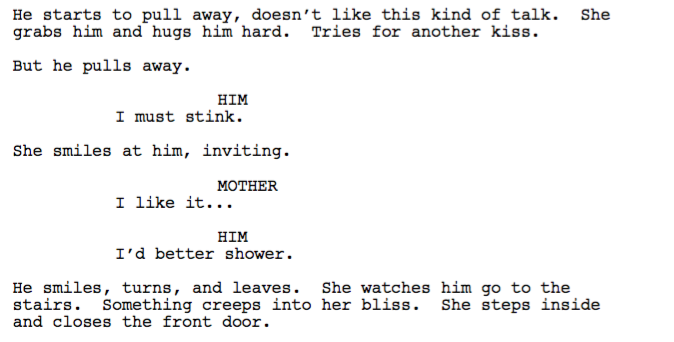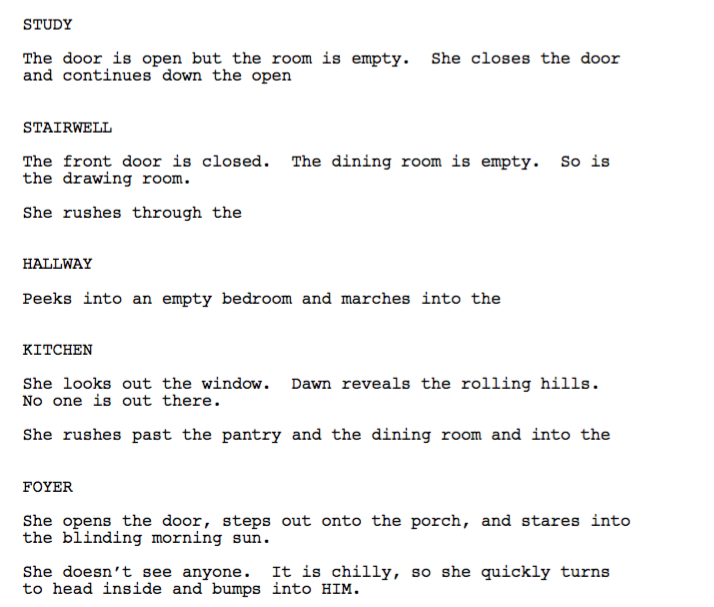With the announcement of the Golden Globe and SAG Award nominations this week, we are officially in the awards race. So from now until Oscars, Jorge will be examining 2017’s most talked-about movies and their screenplays. First, he shows up uninvited at a party...
 mother! is a fever dream. The stream-of-consciousness journey of a woman that just wants people to get the hell out of her space. It’s a biblical allegory, a metaphor for the destruction of the environment, a hallucination of the protagonist. It’s all of these, and it is none.
mother! is a fever dream. The stream-of-consciousness journey of a woman that just wants people to get the hell out of her space. It’s a biblical allegory, a metaphor for the destruction of the environment, a hallucination of the protagonist. It’s all of these, and it is none.
Watching the movie is a trip (take that word for whatever meaning). It’s more visceral than narrative. Trying to find a traditional, cohesive plot in it is useless, and it’s better to experience it through gut reactions of the vignettes presented. But how does the screenplay look? Exactly as you would imagine...

Let’s take a look at the opening sequence, where the characters, and most importantly, the setting is introduced; and see how Aronofsky describes the movement through rooms in the same dream-like vein as the movie moves between scenes.
[Warning! Spoilers below]
mother!
Written by: Darren Aronofsky
[You can read the full script here. I will be talking about these pages]
mother! is a film that slowly spirals down into a frenzied, hectic nightmare. But it actually starts off quite straight-forwardly. We first encounter a burnt down mansion, a mansion that heals itself. This is flash-forward to a later point in the story, which is a very common device in movies. Though, as we will discover later, the looping here is quite different.
Then we are introduced to a woman and her husband living in that same remote country house. He is a writer, and she is there for him. We follow them on a regular morning; he is struggling with writer’s block, and she is redecorating the house. Then a man arrives at their door. It’s an image of (apparent) normalcy that it’s then disrupted.
But the screenplay presents the anomalies of the story right away.

First of all, from a craft standpoint, the script simply looks completely different than how a standard screenplay usually does.
This is something that is far from being something new or ground-breaking, but the characters are not named (they are reduced to “Mother”, “Him”, and later on, “Woman”, “Man,”, “Younger Son”, “Older Son”, etc.), and they lack any visual descriptors whatsoever. They just exist.
The action lines and dialogue are short and abrupt. Somewhat ironically for a movie that relies so much in visual imagery, Aronofsky’s descriptions are incredibly stunted and to-the-point, usually describing basic actions and emotions. He does, however, splatter little fragments here and there that speak volumes about the characters’ state of mind. (“He calms down. Closes his eyes. Wishes.” “He kisses her. She melts into it. Happy.” “Something creeps into her bliss.”)

And, most strikingly reflecting the fluid form of the movie as a whole, there are no scene headers; the scenes are not divided. Mother just moves from one room to the next, as we follow her through the house; from the study to the stairwell to the hallway to the kitchen to the foyer. This is one single movement, in one single space, only separated by an all-caps indicator.
If we are to follow the biblical themes that Aronosfky and Jennifer Lawrence claim the movie represents, and how the narrative we see is a representation of humanity’s relationship with God, religion, and the planet, it makes sense that the movie feels like one, big interconnected sequence. One event immediately bleeds into the next, with no real distinction about the passage of time. And it makes sense that the script would read like that, as well.

Love it or hate it, understand it or not, overhyped or criminally underappreciated, mother! is a statement movie. It is the boldest film by Aronofsky to date, and it is arguably the most difficult to fully assimilate.
But if there’s one thing that can’t be argued is that it is incredibly coherent with itself. And this appears from the moment you read the first page of the screenplay. As the title daringly places that exclamation point, and immediately follows it with a description of “fire everywhere”, you know this is not your regular studio movie.
Remember, the sink is not braced yet.